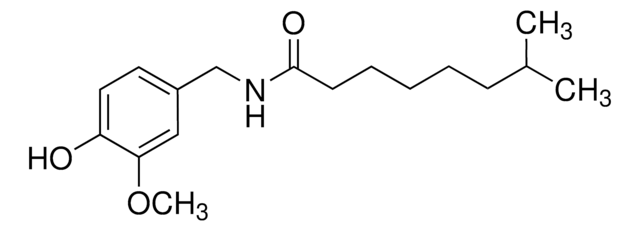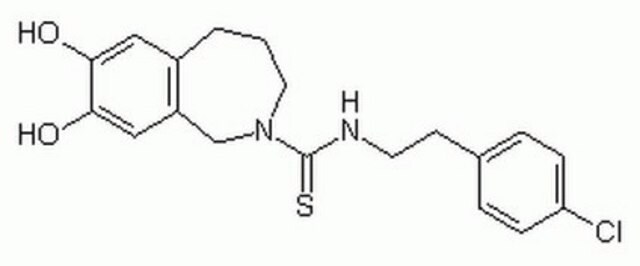This product is not food grade and intended for research use only. Currently, a food grade product option is not available.
M2028
Capsaicin
from Capsicum sp., ≥95% (HPLC), powder, TRPV1 agonist
Sinónimos:
8-Methyl-N-vanillyl-trans-6-nonenamide
Seleccione un Tamaño
Seleccione un Tamaño
About This Item
Productos recomendados
Nombre del producto
Capsaicin, ≥95%, from Capsicum sp.
origen biológico
Capsicum sp.
Nivel de calidad
Ensayo
≥95%
mp
62-65 °C (lit.)
solubilidad
H2O: insoluble
ethanol: soluble
temp. de almacenamiento
2-8°C
cadena SMILES
COc1cc(CNC(=O)CCCC\C=C\C(C)C)ccc1O
InChI
1S/C18H27NO3/c1-14(2)8-6-4-5-7-9-18(21)19-13-15-10-11-16(20)17(12-15)22-3/h6,8,10-12,14,20H,4-5,7,9,13H2,1-3H3,(H,19,21)/b8-6+
Clave InChI
YKPUWZUDDOIDPM-SOFGYWHQSA-N
Información sobre el gen
human ... CYP1A2(1544) , TRPV1(7442)
rat ... Trpv1(83810) , Trpv4(66026)
¿Está buscando productos similares? Visita Guía de comparación de productos
Descripción general
Aplicación
Acciones bioquímicas o fisiológicas
Palabra de señalización
Danger
Frases de peligro
Consejos de prudencia
Clasificaciones de peligro
Acute Tox. 2 Oral - Eye Dam. 1 - Resp. Sens. 1 - Skin Irrit. 2 - Skin Sens. 1 - STOT SE 3
Órganos de actuación
Respiratory system
Código de clase de almacenamiento
6.1A - Combustible acute toxic Cat. 1 and 2 / very toxic hazardous materials
Clase de riesgo para el agua (WGK)
WGK 3
Punto de inflamabilidad (°F)
235.4 °F - closed cup
Punto de inflamabilidad (°C)
113 °C - closed cup
Equipo de protección personal
Eyeshields, Faceshields, Gloves, type P2 (EN 143) respirator cartridges
Elija entre una de las versiones más recientes:
¿Ya tiene este producto?
Encuentre la documentación para los productos que ha comprado recientemente en la Biblioteca de documentos.
Los clientes también vieron
-
Is this food grade? If it is not, is there a food grade option available?
1 answer-
Helpful?
-
-
What is the Department of Transportation shipping information for this product?
1 answer-
Transportation information can be found in Section 14 of the product's (M)SDS.To access the shipping information for this material, use the link on the product detail page for the product.
Helpful?
-
Active Filters
Nuestro equipo de científicos tiene experiencia en todas las áreas de investigación: Ciencias de la vida, Ciencia de los materiales, Síntesis química, Cromatografía, Analítica y muchas otras.
Póngase en contacto con el Servicio técnico












